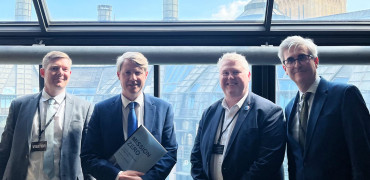Mike Egan, Business Development Manager, highlights the challenges and opportunities for applying new heating and cooling technologies in older university buildings.
With a national footprint of over 21 million m2 and growing, UK universities manage a significant size and range of buildings. A modern campus can encompass anything from lecture theatres to specialist laboratories, on-site data centres, and student accommodation.
In 2023, the Royal Anniversary Trust highlighted the challenge this poses when it comes to shrinking the sector’s carbon footprint. The Trust’s report Accelerating to Net Zero states that tertiary education sector (all education for over-18s) emissions across Scope 1, 2 and 3 are 18.1 million tonnes CO2e (carbon dioxide equivalent).
Universities account for 86% of that figure, of which 19% is produced by its built environment using fuel on-site (e.g., natural gas) and electricity. According to figures from the recent AUDE report on UK universities, total carbon emissions from the UK university estate in 2022 averaged 55.1 kg CO2/m2, up from 54.6 kg CO2/m2 in the previous year.
Young people strongly prefer institutions that show a solid commitment to tackling climate change
Energy bills
On a purely financial basis, energy use in universities is also something that facilities and engineering teams must tackle.
Research from the Association of University Directors of Estates (AUDE) shows that the total energy expenditure for the sector is £379 million, which represents 18% of total property costs – just behind the £661 million (32%) for repairs and maintenance.
Universities have quickly taken the lead in setting their carbon reduction goals. In many cases, these go beyond the UK’s national 2050 Net Zero Carbon target.
Young people who attend university strongly prefer institutions that show a solid commitment to tackling climate change – and they want to see that in action at their university.
HVAC systems are significant energy users in buildings of all types, so it makes sense for university engineers to consider how they can optimise performance – or install more efficient alternatives.
With so many building types to consider on a university campus and tight maintenance schedules, updating equipment such as boilers or air conditioning with a like-for-like approach can be tempting, assuming that newer equipment will be more efficient. However, this is not necessarily true and won’t address the carbon challenge.
Getting rid of gas
For engineering teams looking to decarbonise campuses and make energy savings, removing fossil fuels in the form of gas or oil boilers from the campus environment makes sense.
This means looking at alternatives such as heat pumps which can be applied to a wide range of buildings, from leisure centres to administrative offices and student accommodation.
An important benefit of this approach is that government grants are available to higher education institutions to help them access technical advice and purchase low-carbon equipment.
These include the Public Sector Decarbonisation Scheme (PSDS, also known as the Salix Scheme). This supports the purchasing of technical advice for upgrade projects, as well as offering grants for new equipment.
All-electric universities
Several universities are taking the ‘all-electric’ route for their buildings, removing the need for on-campus fossil fuels altogether. For example, the University of Salford used heat pump technology in its first all-electric building. Its four-storey 15,550 square metre Science, Environment and Engineering Building provides space for students working in physics, electronics and other sciences.
The building benefits from four Mitsubishi Electric air source heat pumps and one Mitsubishi Electric chiller. The innovative design allows the university to re-use ‘waste’ heat that would have been expelled to the outdoor air to ‘heat’ the plant room, where the heat pumps have been installed, to boost the system’s overall efficiency.
In addition, artificially increasing the temperature of the plant room around the heat pumps adds to the system’s overall efficiency.
This project highlights that ‘system thinking’ can yield the most effective results.
Combining low-carbon technology with heat recovery makes the entire system more efficient, lowering the building’s overall carbon footprint and saving energy.
Using the right tool for the job
It’s also important to be realistic about selecting the right equipment for each building and its requirements.
For example, VRF air conditioning can help to decarbonise heating in buildings where it may not be possible to use a heat pump to replace a gas boiler. It’s a good alternative for offices or classrooms with cooling and heating requirements but less need for hot water.
VRF systems have a small footprint and offer a scalable solution that can be installed in phases (for example, floor-by-floor). This can be particularly useful when a building is undergoing a change of use.
Adding energy-efficient cooling capability with VRF can also provide improved indoor environments for occupants. And modern VRF systems use low-GWP refrigerants such as R32, reducing their embodied carbon.
Taking back control
Refurbishment projects provide an excellent opportunity to update ageing control technology, for example, by making the most of cloud connectivity to collect data on building performance.
And monitoring and control technology at a room-based level can help avoid the problem of heating or cooling unoccupied spaces by providing a demand-based approach that ensures systems only run when needed. Technology such as PIR (passive infrared) room sensors can switch systems such as cooling on or off based on room occupancy sensor feedback. This reduces the need for occupants to touch control panels (helping to maintain hygiene) and save energy by switching off cooling in unoccupied spaces.
The university sector has recognised the need to accelerate its transition to low-carbon energy sources while ensuring the entire estate is as energy efficient as possible. The sector is undoubtedly leading the way, and many university engineering teams have set high standards in adopting sustainable technologies and approaches.
Building services are significant energy users in buildings across the campuses. But modern equipment can provide cost-effective solutions that deliver low-carbon systems and reduce energy waste while providing better indoor environments for staff and students alike.
Mike Egan, Business Development Manager




